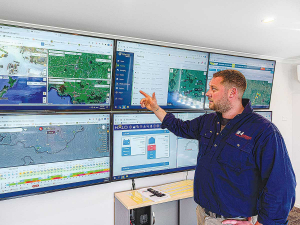Fleet tracking helps operation save time and money
Herberts Transport is a rural transport company, established in 1918, that operates a mixed fleet of around 50 vehicles, including livestock, bulk trucks, spreaders, whey trucks and trailers.
 Herbert's Transport managing director Scott Hutton says having a full overview of where all the vehicles in his fleet are and what they're doing translates into better communication with their farming customers.
Herbert's Transport managing director Scott Hutton says having a full overview of where all the vehicles in his fleet are and what they're doing translates into better communication with their farming customers.
Southland based Herbert’s Transport is a rural transport company that operates a mixed fleet of around 50 vehicles – including livestock, bulk trucks, spreaders, whey trucks and trailers.
Alongside carting products from the dairy giant Fonterra, they also carry gravel, cement, coal, operate vacuum trucks as well as run a fleet of modern tractors, slurry spreaders and muck spreaders. As a business that supports the overall agriculture industry, like many farmers, Herbert’s has a similar focus on increased efficiency to keep up with demand and support overall productivity.
This led the company to look for an easy-to-use tracking system to provide an overview of the status and location of all their fleet. It also wanted other features like service alerts and electronic Road User Charge reconciliation – to help eliminate time consuming manual processes and better serve their rural customers.
Extensive research led to the installation of Teletrac Navman’s GPS-based fleet tracking system. Alongside streamlining operations, the system has also delivered large cost and time savings.
Managing director Scott Hutton says having a full overview of where all the vehicles in his fleet are and what they’re doing, translates into better communication with their farming customers, less admin time and a well-maintained fleet.
“Through the app on my phone, I can quickly check the status of all divisions of vehicles through the easy-to-use overview,” he explains. “So, if a farmer asks about our ETA, I can easily check the truck location on the app and let them know.”
Hutton says this saves time for both the farmers, who can better manage exactly when they need to meet trucks at the gate with other tasks and Herbert’s Transport.
He adds that servicing rural areas also means operators need to be on top of Road User Charges (RUC) to ensure they don’t get caught without a licence or lose out on rebates – the latter has a significant impact on a company’s bottom line.
Herbert Transport is using electronic RUC monitoring for both its diesel fleet vehicles and independent trailers. Because it automates RUC licencing and rebates, it calculates each distance travelled on private roads to provide correct rebates.
Hutton says previously managing the RUC on independent trailers was impractical and time-consuming. It only needed one broken wire or a driver with multiple trailers to manually enter the wrong RUC details, and it would affect the data – causing headaches down the line.
He says, combined with the auto purchasing technology, the system saves the Herbert’s team at least a couple of hours a week in administration time.
“When submitting the rebates for private roads, all the info is there. We just click on a button to submit and that means more time saved,” Hutton says.
Red meat farmers and processors are welcoming a US Government announcement - removing its reciprocal tariffs on a range of food products, including New Zealand beef.
OPINION: As negotiations advance on the India-New Zealand FTA, it’s important to remember the joint commitment made by Indian Prime Minister Narendra Modi and New Zealand Prime Minister Christopher Luxon at the beginning of this process in March: for a balanced, ambitious, comprehensive, and mutually beneficial agreement.
Minister for Universities, Shane Reti, has opened the final new build in a ten plus year project to upgrade the veterinary facilities at Massey University.
As New Zealand experiences more frequent and severe flooding events, the Insurance & Financial Services Ombudsman Scheme (IFSO Scheme) is urging consumers to be honest and accurate when making insurance claims for flood damage.
A recently held arable field day in the Manawatu brought with it a timely reminder to be on the lookout for velvetleaf incursions.
In a significant shift for employers, wage theft is no longer only a civil matter but now also a criminal one.